Photo
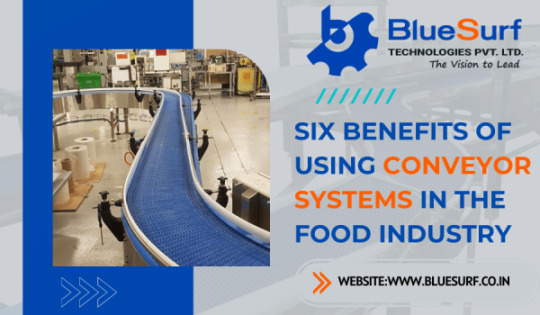
must be transported over long distances while remaining sanitary. Previously, food processing plants relied solely on manual labour to perform these functions, which consumed a significant amount of time and money. However, increasing levels of automation, such as the use of food handling conveyors, have transformed these operations. Continue reading to learn how food conveyor systems have improved quality, production efficiencies, and worker safety in the food industry.
0 notes
Link
Conveyors are excellent investments that help food manufacturers save money on labour, improve processes and productivity, and maintain food quality standards.
Please feel free to contact Bluesurf Technologies if you have any questions about using a conveyor system in your food production facility. We specialise in providing top-of-the-line conveyors to various food processing plants in order to help them grow their business.
1 note
·
View note
Text
Six Benefits of Using Conveyor Systems in the Food Industry
Material handling is essential in food processing and packaging. Raw materials and finished goods must be transported over long distances while remaining sanitary. Previously, food processing plants relied solely on manual labour to perform these functions, which consumed a significant amount of time and money. However, increasing levels of automation, such as the use of food handling conveyors, have transformed these operations. Continue reading to learn how food conveyor systems have improved quality, production efficiencies, and worker safety in the food industry.
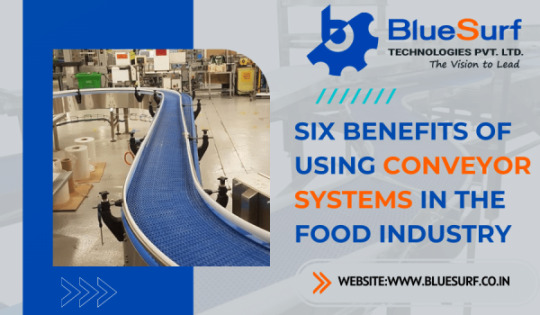
History of Conveyor Systems
Conveyor belts were first documented in 1795. The first conveyor system was powered by pulleys and hand cranks and was made of a wooden bed and a leather belt. The primitive design of the first conveyor systems was improved by the Industrial Revolution and steam power. By 1804, the British Navy was loading ships using steam-powered conveyor systems.
Over the next 100 years, machine-powered conveyors would appear in a variety of industries. Sandvik, a Swedish engineering firm, produced the first steel conveyor belts in 1901. Conveyor belt systems, which were previously built with leather, rubber, or canvas belts, began using different fabrics or a combination of synthetic materials for the belts.
Conveyor systems have evolved over the years and are no longer powered solely by hand or gravity. In today’s food industry, mechanical conveyor systems are widely used to improve food quality, operational efficiencies, productivity, and safety. Mechanical conveyors are made up of a power mechanism that controls the conveying speed, a motor controller, a structure that supports the conveyor, and a material-handling mechanism such as a belt, tube, tray, or screw.
Conveyor Systems Today
Belt conveyors, vibrating conveyors, screw conveyors, flexible screw conveyors, aero-mechanical conveyors, and tubular cable drag conveyor systems are the most common conveyors used in the food industry today.
Today’s technologies enable customised designs based on the client’s needs, such as how far materials need to be moved or at what speed these items will travel through the plant.
Modern conveyor systems can also be custom-designed by consulting experts who know exactly where power points are located within the facility so that everything runs smoothly and without hiccups from start to finish.
Advantages of Food Handling Conveyors
Increased automation in the form of food conveyor systems has provided benefits to the food industry that go beyond improved sanitation. Conveyors provided numerous benefits to food manufacturers who installed them. Among the primary advantages are:
#1. Increased Productivity
When compared to using human labour, a conveyor system will complete your food processing activities much faster. Check out this page for more information on its operating systems. More work will be completed in a shorter period of time, increasing your company’s productivity levels. This frequently translates to higher returns, which is what every business desires.
Without a conveyor system, these processes will be handled by your team. This means that the top leadership must oversee the execution of operations to ensure that they are done correctly and without redundancy. Top management will be less productive as a result of the supervision.
With a conveyor system, however, they can concentrate on other core managerial operations that will result in profit realisation. This boosts productivity not only for your top management but also for your company.
2. Reduced Costs
When you run your food processing operations without a conveyor system, you must invest in a large number of workers. Because production is frequently done 24 hours a day to meet market demand, you must double your team, one for the day and one for the night shift. This means you’ll have to pay a lot of money to accommodate them, from wages to insurance to other benefits.
However, with the conveyor system, fewer workers are required. You may only require one or two on the ground. They will oversee the process to ensure that everything runs smoothly. Your operating costs will be reduced as you reduce the number of employees.
3. Increase Employee Safety
Employees are delegated to less physically demanding operations as the need for manual labour in food processing shifts to conveyor systems. The reduced amount of handling reduces the number of injuries on the job site caused by strenuous tasks.
Shifting the load from the worker to the conveyor reduces the risk of food product damage. You can adjust the speed, height, and include barriers to keep your conveyor system safe for employees.
4.Fewer Errors
When human labour is used to complete any task, there is always a high likelihood of error. This is frequently attributed to exhaustion, ignorance, or a lack of knowledge.
Errors in food production increase the likelihood of quality being compromised or systems being disrupted. How?
A worker may use the incorrect amount of an ingredient or place it in the incorrect chamber. If this is discovered early on, the production process can be repeated to correct the situation. On the other hand, if it goes unnoticed, what does that say about the final product’s quality?
When you use a conveyor system, however, everything will go as planned; there will be no deviations in the procedure. This means that quality is maintained throughout, increasing the likelihood of your company fully satisfying the needs of your clients. To ensure this, simply programme it correctly and without errors.
5. Ensuring Food Safety and Maintaining Quality Standards
There are various standards that must be met in the food production process to ensure that the final product is fit for human consumption. This means that you must maintain high levels of hygiene in your manufacturing.
When using human labour, maintaining these standards may be difficult because someone may compromise something, with or without their knowledge. A minor lapse in quality control may render an entire batch unfit for human consumption.
The use of a conveyor system alters the narrative. There are conveyor systems designed for food production that are often sterile and anti-bacterial. This means that your food will always meet minimum quality standards that will be upheld throughout the process. To keep the conveyor belts sterile, simply clean them on a regular basis with the appropriate products.
6. Increased Versatility
Conveyor systems can change the speed and direction of material flow, making them a versatile addition to food processing operations. Because conveyors are modular, they can be reconfigured to meet changing production needs.
Conclusion
If you’re looking to expand your operations, a conveyor system is the way to go. The size of your production plant, as well as your budget, is the most important factors to consider when making this investment. You will benefit from the methods described in this article if you use a conveyor system.
Conveyor systems were initially developed to reduce the time required to move materials from point A to point B and to relieve workers of strenuous manual labour. Conveyor systems have evolved over time and now provide more benefits. Conveyors are excellent investments that help food manufacturers save money on labour, improve processes and productivity, and maintain food quality standards.
Please feel free to contact Bluesurf Technologies if you have any questions about using a conveyor system in your food production facility. We specialise in providing top-of-the-line conveyors to various food processing plants in order to help them grow their business.
0 notes
Photo

Efficient Packaging Solutions for Confectionery and Snacks: We provide turnkey automated confectionery packaging and processing systems. Our expert in-house team develops high-speed machines as part of complete lines to handle all types of confectionery
.Our goal with any candy packaging machine or processing solution is to improve the production line's Overall Equipment Effectiveness (OEE). We design and develop solutions with the primary goal of increasing productivity and time efficiency. We design and build automated solutions to meet your needs, from secondary packaging to cutting and product handling technologies.
Get In Touch With Experts, Request a quote now at
More info visit:https://bit.ly/3lTYfES
#automatedconfectionerypackaging#candypackagingmachine#Confectioneryitems#automatedsolutions#bluesurf
0 notes
Photo

Top 8 Manufacturing Trends For 2022:
Manufacturers are constantly striving to overcome challenges, improve processes, and identify efficiencies, and the manufacturing trends we predict for 2022 will all serve to further these objectives. As with any new year, technological advances, market needs, and business objectives will drive manufacturing industry trends.Bluesurf Technologies can help with your challenges and objectives for 2022 and beyond to lead your operations into the next decade. For more information, contact Bluesurf Technologies today.
0 notes
Text
Top 8 Manufacturing Trends For 2022

Trend #1. Manufacturers Will Continue to Deal with Labor Shortages
The labour shortage is nothing new; the National Association of Manufacturers forecasted a 2.1 million manufacturing job gap by 2030 in 2019. Indeed, between February 2020 and December 2021, the Bureau of Labor Statistics reported a loss of 219,000 manufacturing jobs. This shortage will be exacerbated by the loss of skills and knowledge as current workers retire. Manufacturers can get ahead of this trend by doing the following:
1.Improving public perception of manufacturing jobs
2.Recruiting from industries hardest hit by the pandemic
3.Reskilling current employees
4.Increasing efforts to retain workers investing in more automation
By increasing system uptime and line output, our custom conveying solutions can assist manufacturers in dealing with labour shortages.
Trend # 2. Data-Driven Maintenance as a Margin Enhancer
Sensors, remote monitoring, connected devices, and the Internet of Things (IOT) have all appeared on trend lists in recent years, and this year is no exception. Why? On the one hand, sensors are becoming more common, communications are becoming faster and more reliable, and manufacturers are developing more effective ways to use data to drive predictive maintenance, among other things. Given the financial difficulties that many facilities faced in 2020 and 2021, and may face in 2022, more effective, efficient maintenance is critical. Because predictive maintenance can drastically reduce unplanned downtime, material cost savings are more important than ever.
Trend # 3. Manufacturers Will Renew Efforts to Their Supply Chains
Another 2022 manufacturing industry trend will be corporate efforts to control supply chains. The ongoing effects of COVID-19, trade wars, high demand, and long delivery times are putting manufacturers’ ability to build resilient supply chains to the test. Many will seek to reshore operations in order to better manage supply chain availability, while others will look for opportunities in countries such as Canada and Mexico. Their efforts will be hampered by ongoing transportation issues, such as a lack of freight drivers and congestion at U.S. container ports.
Trend # 4. Environmental Accountability Will Gain the Forefront
Another 2022 manufacturing industry trend will be corporate efforts to control supply chains. The ongoing effects of COVID-19, trade wars, high demand, and long delivery times are putting manufacturers’ ability to build resilient supply chains to the test. Many will seek to reshore operations in order to better manage supply chain availability, while others will look for opportunities in countries such as Canada and Mexico. Their efforts will be hampered by ongoing transportation issues, such as a lack of freight drivers and congestion at U.S. container ports.
Trend # 5. Cybersecurity Will Emerge as a Major Threat
Without mentioning cybersecurity, no discussion of current manufacturing trends would be complete. Cybersecurity has become a major concern for manufacturers as a result of high-profile cyber attacks on both industry and government. Ransomware and other cybersecurity vulnerabilities can affect operations of any size. No company is immune to a cyber-attack.
Manufacturers’ exposure to cyber threats grows as their reliance on 5G-connected devices grows. The dangers are real, and they can affect both the factory floor and the back office. Most legacy systems and technologies were not designed to withstand cyber-attacks. Improving security isn’t the only requirement. Companies must also consider their corporate resilience in the event of an attack. Is vital data and documentation backed up on a regular basis to provide the redundancy required to withstand an attack? Every aspect of a manufacturer’s operations is affected by cybersecurity.
#6 - Don’t Ignore Issues
Workers on automated conveyor systems should be aware that they should alert a supervisor right away if they experience any problems. Employees need to be taught the importance of reporting suspicious activity. It’s always better to be safe than sorry, regardless of how minor the problem may seem.
Trend # 7. Increased Reliance on Virtual Processes
Digital twins, machine learning, AI (artificial intelligence), AR and VR (augmented reality and virtual reality) technologies are assisting manufacturers in navigating COVID challenges by enabling remote monitoring, servicing, and equipment operation — all without the need for on-site personnel. With communication approaching real-time and the computing power to make it appear as if the operator is in the same room as the machine, virtual and remote operation is consistent with other recent manufacturing process trends that enable access, flexibility, and safety.
Trend # 8: Automation and Robotics are Redefining Manufacturing Worker Roles
Automation is not a new phenomenon in the manufacturing industry. However, manufacturers are investing more money than ever before in automated solutions for their operations. This is especially true in the agriculture and food manufacturing industries. Indeed, the global agricultural robotics market is expected to be worth $6.7 billion by 2032.
Many agricultural robotics startups have recently received funding boosts. Carbon Robotics, for example, received $27 million in Series B funding for their autonomous weeding robot. Tortuga, a harvest automation startup, raised $20 million in funding.
The emphasis on automation and robotics is changing the structure and distribution of labour in the manufacturing industry. Companies must reconsider how to make the best use of their workforce.
Frontline workers in manufacturing will most likely take on roles and responsibilities that require them to use their communication and collaboration skills more frequently. Platforms that enable manufacturing upskilling and employee engagement will become more common as we approach 2022.
Bluesurf Technologies can help with your challenges and objectives for 2022 and beyond to lead your operations into the next decade. For more information, contact Bluesurf Technologies today.
#Manufacturing Trends#Manufacturing Trends 2022#Manufacturers#manufacturing industry#automation solutions
0 notes
Photo
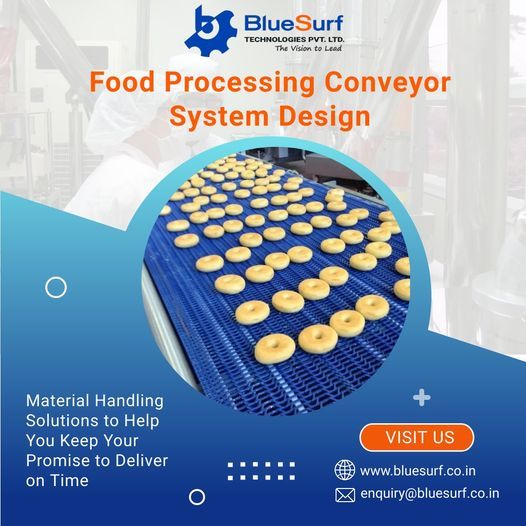
Conveyor System Design: Improve Efficiency, Reduce Labor, and Gain a Competitive Edge with Our Conveyor System Design Services:We can design, commission, and install a conveyor system that works for you, whether you need a complete system solution for a new facility or are renovating an existing facility.Request For A Quote Now [email protected] Info Visit Us:https://bit.ly/3PwoGye
#conveyorsystemdesign#packaging#packagingindustry#FoodConveyorsdesign#foodconveyors#conveyorsystems#conveyors#conveyorbelt
0 notes
Photo
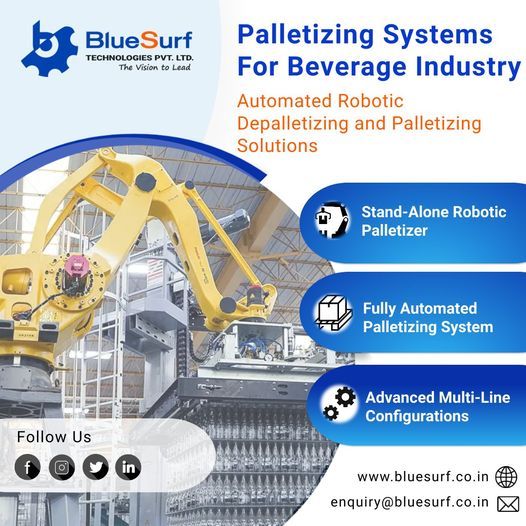
Depalletizing and Palletizing Solutions for Beverage Industry:Robotic palletizer or conventional palletizing systems, Bluesurf machines are designed with a modular principle in mind. The main characteristics are increased performance in palletizing and depalletizing with minimal maintenance and spare parts, a consistent control concept, good accessibility to all elements, and short retooling times.Get In Touch With Experts, Request a quote now at [email protected] info visit:https://bit.ly/38JJhhU
#Palletizingdesigns#secondarypackaging#palletizing#foodandbeverages#DepalletizingandPalletizingSolutions#DepalletizingSolutions
0 notes
Photo

Cutting Edge Palletizing Designs For The Food And Beverage Industry: Reduce Your Packing And Shipping Time:Effective palletizing makes it easier to move bulk amounts of product from the producer to the destination. Whether it is a retail store, distribution center, or another production line, palletizing is important to the safety of the product. it provides protection from environmental hazards experienced during transportation and keeps the packages safe during storage.Secondary packaging flows directly into palletizing even between rooms or across your plant. this is where our years of holistic automation design pay off for you. we can dramatically reduce the risk of damage or spoilage through automation. our engineers find the most efficient route between secondary packaging and palletizing. we keep your products and employees safe while speeding them out the door.Let’s see what we can do for you!Request for a quote Now [email protected] info visit: www.bluesurf.co.in
#Palletizingdesigns#palletizing#secondarypackaging#foodandbeverages#secondarypackagingsolution#bluesurf
0 notes
Photo

Bluesurf Technologies strives to make the best conveyor belts possible every day, regardless of whether your company is in the manufacturing, food, beverage, Dairy, Bakery & Confectionary or any other industry. Get advice from our team of experts if you have any questions about Conveyor System Design Or conveyor belt safety by getting in touch with us right away.
#Conveyor Safety#Conveyor Belt#Conveyor Safety Tips#Conveyor System Design#Conveyor System#Conveyor belt Safety
0 notes
Photo
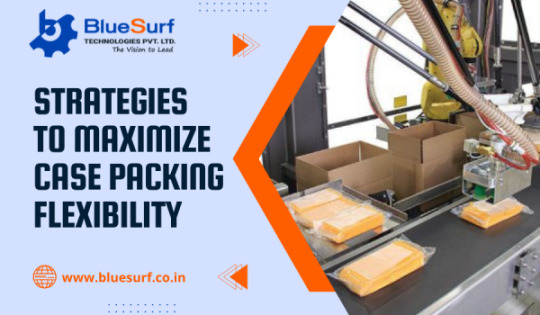
Bluesurf Technologies’ case packer’s solution aids in the optimization of your workflow and the delivery of dependable product packaging. Please contact us right away to find the best case packing solution for your facility’s packaging line.
0 notes
Link
Bluesurf Technologies strives to make the best conveyor belts possible every day, regardless of whether your company is in the manufacturing, food, beverage, Dairy, Bakery & Confectionary or any other industry. Get advice from our team of experts if you have any questions about Conveyor System Design Or conveyor belt safety by getting in touch with us right away.
#Conveyor Safety#Conveyor Belt#Conveyor Safety Tips#Conveyor System Design#Conveyor System#Conveyor belt Safety
0 notes
Link
Bluesurf Technologies’ case packer’s solution aids in the optimization of your workflow and the delivery of dependable product packaging. Please contact us right away to find the best case packing solution for your facility’s packaging line.
0 notes
Text
Conveyor Safety – Top 8 Tips to Minimize Conveyor Belt Risks
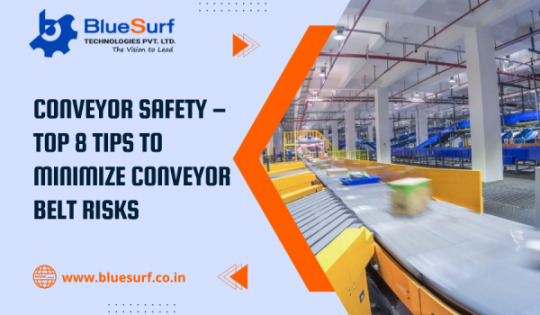
Conveyor belt safety should always be your top priority if any automated conveyor systems are used in your company. The U.S. Bureau of Labor Statistics reports that conveyor accidents cause 9,000 injuries and over 40 workplace fatalities each year.
There are some conveyor belt hazards to be aware of to help decrease injuries related to conveyors, regardless of the type of conveyor being used in your company. Even though it’s impossible to keep every accident from happening in your warehouse or factory, there are a few useful conveyor safety guidelines to remember. We’ll look at eight of the most important dos and don’ts for operating automated conveyor systems in this article.
Are You Looking For Automated Product Packaging Services?
Bluesurf Technologies automation solutions help prevent inconsistent recipes, unexpected overflows and other mistakes that can produce waste, ruin entire batches, and hurt the bottom line.
GET IN TOUCH WITH EXPERT
#1 -Don't sit, stand, or walk on conveyors
On the conveyor belt, employees should never stand, sit, climb, or move around. Safety must always come first, and these actions are very risky (even if they look fun). People were not intended to climb or walk on conveyor belts. Even when conveyor pinch point guards have been installed, there are numerous pinch points in every conveyor system that could trap people or clothing and cause serious injuries. Aside from the potential for injury, people using conveyors run the risk of causing the belts to derail, which would harm the entire system.
#2 - Make sure conveyor controls are operating correctly
Anyone working with conveyor belts should be familiar with where to locate the system’s emergency stop and start controls. Employees will then be equipped to respond appropriately in the event of emergencies or other issues.
#3 - Keep hair, clothing, jewellery, and other loose items away
Anything that is not properly restrained, including long hair, body parts, and loose clothing, has the potential to get caught in a conveyor belt and cause serious injuries. Anyone working close to a conveyor should make sure their hair is tied back and remove any jewellery, such as rings, necklaces, watches, and bracelets. This is one of the most important conveyor safety rules you should put into practise. Additionally, workers who are near conveyors should be aware of their appendages and refrain from donning baggy clothing.
#4 - Do Keep Personnel Away From the Conveyor before Starting
According to legal requirements, conveyor systems must have a warning signal that can be activated before starting up. For businesses creating conveyor safety regulations out of concern for their workers, that ought to be just the start. The meaning of the warning signal and any potential risks that may arise if it is disregarded should be explained to employees.
#5 - Check that all conveyor guards are in place
For maintenance, workers or contractors may remove guards, exposing potentially hazardous machinery, chains, gears, and moving parts. Automated conveyor systems should always be locked when in use for the protection of workers, and they should only be turned back on after all conveyor pinch point guards and covers have been successfully replaced.
#6 - Don’t Ignore Issues
Workers on automated conveyor systems should be aware that they should alert a supervisor right away if they experience any problems. Employees need to be taught the importance of reporting suspicious activity. It’s always better to be safe than sorry, regardless of how minor the problem may seem.
#7 - Do Make Conveyor Belt Safety Training a Priority
If your company uses conveyors, every employee should know how to operate them safely before starting work. All visitors should be informed of how to stay safe while they are in your facility, and existing staff should receive regular refresher training on conveyor safety guidelines.
#8 - Don’t Mistreat Controls
Controls for conveyors should only be used by trained personnel. You must regularly check your conveyor controls to ensure that nobody has disconnected, changed, or misused them. Teach your staff that the conveyor belt controls are a part of a larger system and should not be altered without permission.
Choose Bluesurf Technologies for Your Automated Conveyor Systems
Given what you’ve learned about using conveyor systems safety, Bluesurf Technologies can assist you in setting up a conveyor belt system or maintaining an existing one. Bluesurf Technologies strives to make the best conveyor belts possible every day, regardless of whether your company is in the manufacturing, food, beverage, Dairy, Bakery & Confectionary or any other industry. Get advice from our team of experts if you have any questions about Conveyor System Design Or conveyor belt safety by getting in touch with us right away.
#Conveyor Safety#Conveyor Belt#Conveyor Safety Tips#Conveyor System Design#Conveyor System#Conveyor belt Safety
0 notes
Text
Strategies to Maximize Case Packing Flexibility
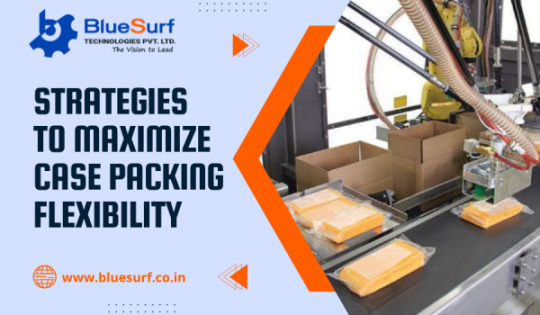
The majority of consumer product companies looking for a custom high speed case packer today want that machine to be versatile. They explain that their proposed packaging line will handle a variety of packages, and that it is critical to be able to accommodate packages that have yet to be designed. Current and future packages will be presented to the case packer in a variety of orientations for possible shipment in Regular Slotted Container (RSC), Half Slotted Container (HSC), trays, five panel wraparound, harness style wraparound, and other style cases.
Manufacturers and co-packers want the flexibility to ship products not only in case counts of 12 and 24, but also in counts of 4, 6, 8, and 10, depending on the needs of their customers. The case packer, on the other hand, must enable high throughput while also minimising changeover time. The operation and maintenance of case packing systems must correspond to the realities of today’s and tomorrow’s workforce skill sets.
To satisfy today’s retail environment, where big box, online, and small and mid-sized specialty retailers all compete for shopper loyalty and patronage, the desire for maximum flexibility, as described above, is required. Retailers of all sizes want something different on their shelves than their competitors. They want products delivered on demand and packaged in a way that reduces handling and waste. They also want product innovations on their shelves and websites to attract and retain customers.
This is a lot of demands to put on a piece of machinery that has traditionally been designed to run a small number of configurations at high speed for 5 to 15 years or more. When looking for maximum flexibility in a case packer, where should the manufacturer and co-packer start?
Are You Looking For Strategies to Maximize Case Packing Flexibility Services?
Bluesurf Technologies automation solutions help prevent inconsistent recipes, unexpected overflows and other mistakes that can produce waste, ruin entire batches, and hurt the bottom line.
GET IN TOUCH WITH EXPERT
Create a list of specifications that accurately reflect the expected diversity on the line before meeting with the custom original equipment manufacturer (OEM).
Understand the fundamental capabilities of top load and side load case packers because they are quite different, and this knowledge will be useful background.
Find and work with an OEM that the acquisition team believes in, because there will inevitably be tradeoffs and compromises. The foundation for a successful project is trust.
As with any equipment purchase, it is critical to select the case packer that is best suited to your specific workflow and business requirements. Make the most of your case packing solution by implementing these strategies to maximise case packing flexibility in your facility.
Put Your Products First
When choosing a case packer solution, your products should be at the forefront of your mind. The products that pass through your packaging line have a significant impact on the pack patterns, case formats, and other packaging details required by your case packer.
You should also consider the packaging dimensions required to safely and efficiently pack your products and move them through the supply chain. These specifications will help you choose a case packer that is suitable for the products that go through your packaging line.
Choose a Packer That Handles Multiple Formats
Different products necessitate distinct packaging solutions. Investing in a case packer that can handle multiple formats is essential for anticipating your needs both now and in the future.
Bluesurf Technologies’ fully automatic case packaging machine is capable of shrink wrapping as well as case packing. This machine can handle all of the traditional case packing formats, including wraparound, tray, and film, allowing you to move all of your products through your packaging line quickly. When you choose a packer that offers automatic format changeovers between packaging formats, you can worry less about format changes and focus more on delivering stable products in high-quality packaging.
Look for Quick Changeover Capabilities
Investing in quick changeover capabilities is a critical strategy for increasing case packing flexibility. A case packer that allows for easy format changes maximises your flexibility while also providing superior uptime efficiency and productivity to your facility. Format changes are performed electronically by Bluesurf Technologies case packers with automatic format-change capabilities, without the assistance of operators. This saves employees’ time and allows products to pass through this stage of your packaging line with less supervision.
Bluesurf Technologies’ case packer’s solution aids in the optimization of your workflow and the delivery of dependable product packaging. Please contact us right away to find the best case packing solution for your facility’s packaging line.
0 notes
Photo
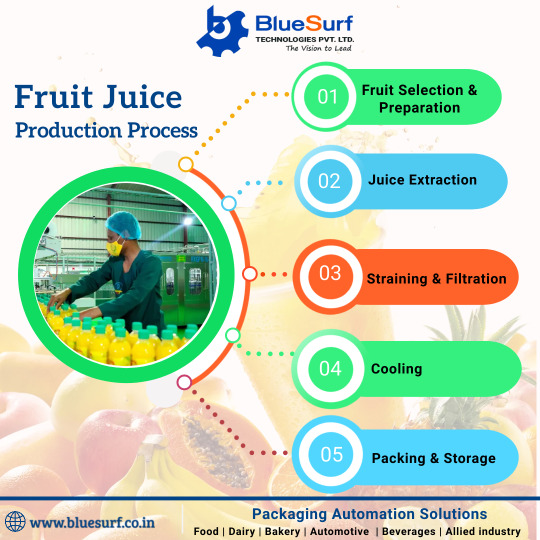
Increase Profit & Reduce Food Waste Today!
The production process for fruit juices is fairly standard, regardless of the type of juice you are making. The process starts with the pretreatment of raw fruit material and then moves to extraction, clarification, and filtration. From there, the production process continues with homogenization, deoxidation, concentration, and ingredient adjustments.
Collaborate with Blusurf Technologies for food process optimization solution.
Request For A Quote Now [email protected]
More Info Visit Us:https://bit.ly/3PwoGye
#bluesurf#bluesurftechnologies#EnergyEfficientSolutions#foodprocessing#foodandbeverageindustry#dairyprocessing
0 notes
Photo

India's Chess Prodigy, R Praggnanandhaa, Beats World Champion Magnus Carlsen For Second Time
.
.
0 notes